 W
WThe Amiot 110, also known as the Amiot-SECM 110, was a French prototype interceptor designed and built in 1929.
 W
WThe Aviméta 88 was an all-metal French two-seat reconnaissance-fighter or heavy fighter tested in 1927.
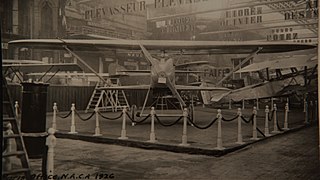 W
WThe Bernard 15 C1 or Bernard SIMB AB 15 was a 1920s French single-seat sesquiplane fighter aircraft designed and built by the Société Industrielle des Métaux et du Bois (SIMB). With the structural failure of the earlier Bernard 14 the Bernard 15 was an improved variant with a greater span upper wing. It was powered by a Hispano-Suiza 12Hb inline piston engine and had a fixed tailskid landing gear. The performance was not an improvement on the Bernard SIMB AB 14 and only the prototype was built.
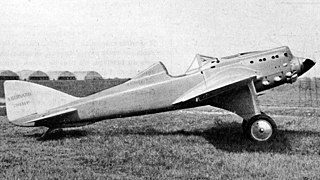 W
WThe Bernard 20 was a 1920s French single-seat monoplane fighter aircraft designed and built by the Société des Avions Bernard. Originally displayed as a mock-up at the 1928 Paris Air Show it was a low-wing monoplane based on the Bernard V2 racer. The prototype powered by a 400 hp (298 kW) Hispano-Suiza 12Jb inline piston engine first flew in July 1929 from Orly. With its racing inheritance, in 1930 the aircraft flew at a speed of 280 km/h (174 mph). With the lack of interest by the French authorities for monoplanes the project was abandoned after 18 months of test flying.
 W
WThe Bernard SIMB AB 12 was a French single engine, single-seat monoplane fighter aircraft built in the 1920s. Though advanced for its time, it failed to gain a production order and only one was built.
 W
WThe Bernard SIMB AB 14 was a 1920s French single-seat sesquiplane fighter aircraft designed and built by the Société Industrielle des Métaux et du Bois (SIMB). With a reluctance of the French authorities to purchase monoplanes the Bernard 14 was designed as a sesquiplane with Y-form struts bracing the wings on each side. It was powered by a Hispano-Suiza 12Hb inline piston engine and had a fixed tailskid landing gear. While on a test flight on 22 February 1926 the aircraft suffered a catastrophic structural failure of the upper wing and the only Bernard 14 was destroyed.
 W
WThe Bleriot-SPAD S.51 was a French fighter aircraft developed in 1924 in response to a French Air Force requirement for an aircraft to replace their obsolete Nieuport-Delage NiD.29s.
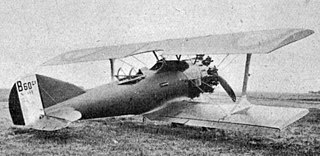 W
WThe Blériot-SPAD S.60 was a French fighter aircraft developed in the late 1920s.
 W
WThe Blériot-SPAD S.61 was a French fighter aircraft developed in 1923. Designed by André Herbemont, the S.61 was a conventional biplane, abandoning the swept upper wing used by Herbemont in several previous designs. The prototype S.61 was evaluated by the French Air Force alongside the S.51 as a potential new fighter, but like its stablemate, was rejected. The Polish Air Force was impressed enough to order 250, as well as purchase licences for local production. The Romanian Air Force also ordered 100 aircraft. About 30 were built in Poland, by the CWL.
 W
WThe Blériot-SPAD S.91 was a French light-weight fighter aircraft. It would be later developed into the Blériot-SPAD S.510, the last biplane produced by the French aeronautic industries.
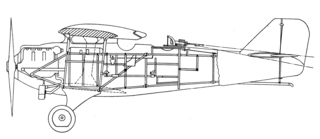 W
WThe Bréguet 25 or XXV was a French two seat fighter from 1925. It was heavily armed, carrying seven machine guns.
 W
WThe CAMS 31 was a 1920s French single-seat fighter biplane flying-boat designed and built by Chantiers Aéro-Maritimes de la Seine (CAMS).
 W
WThe Dewoitine D.1 was a French single-seat fighter aircraft of the 1920s, built by the French industrial company Dewoitine.
 W
WThe Dewoitine D.9 was a French monoplane fighter built by Dewoitine and built under licence in Italy as the Ansaldo AC.3.
 W
WThe Dewoitine D.19 was a fighter aircraft built in France in 1925 in response to a French Air Force solicitation.
 W
WThe Dewoitine D.21 was 1920s French open-cockpit, fixed-undercarriage monoplane fighter aircraft.
 W
WThe Dewoitine D.27 was a parasol monoplane fighter aircraft designed by Émile Dewoitine in 1928.
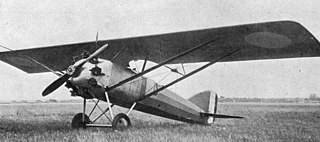 W
WThe Gourdou-Leseurre GL.30 was a racing aircraft built in France in 1920 which formed the basis for a highly successful family of fighter aircraft based on the same design.
 W
WThe Hanriot H.26 was a French single seat fighter aircraft prototype completed in 1923. Only one was built.
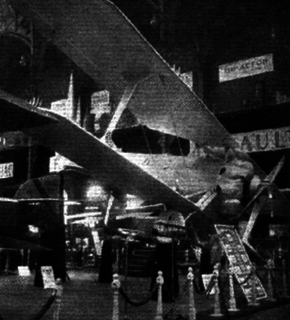 W
WThe Hanriot H.31 was a single engine, single seat French biplane fighter aircraft built in 1925 to compete in a government programme. It was not successful and only one prototype was completed.
 W
WThe Hanriot HD.15 was a French two seat fighter aircraft fitted with a supercharger for good high altitude performance, built in the 1920s. Three were ordered by Japan but lost at sea during delivery.
 W
WThe Les Mureaux 3 C.2 and Les Mureaux 4 C.2 were French two seat, parasol winged fighters, flown in 1927-8, which differed only in their engines. They were developed into near identical army co-operation types, the ANF Les Mureaux 130 A.2 and ANF Les Mureaux 131 A.2, in 1929-31.
 W
WThe Levasseur PL.5 was a carrier-based fighter produced in France in the late 1920s, in response to the 1924 AMBC.2 specification issued by the Service Technique de l'Aéronautique (STAé). It was a conventional, single-bay sesquiplane that carried a crew of two in tandem, open cockpits. Like other Levasseur naval designs of the day, it incorporated several safety features in case of ditching at sea. Apart from small floats attached directly to the undersides of the lower wing, the main units of the fixed, tail-skid undercarriage could be jettisoned in flight, and the underside of the fuselage was given a boat-like shape and made watertight.
 W
WThe Levasseur PL.6 C.2, also known as Levasseur VI C.2, was a two-seat fighter aircraft built in France in 1926 in order to meet a 1925 C.2 Service Technique de l'Aéronautique (STAé) specification,. Constructed along the same lines as Levasseur's naval aircraft of the same era, it was a conventional, single-bay biplane with seating for the pilot and tail gunner in separate, open cockpits. Flight testing of the prototype commenced in 1926, and it was exhibited at the Salon de l'Aéronautique at the end of the year.
 W
WThe Levy Biche LB.2 was a single seat French sesquiplane fighter aircraft designed to be used from aircraft carriers. With a watertight fuselage, jettisonable wheeled undercarriage and small under-wing floats, it could survive emergency sea touchdowns; it could also be fitted with seaplane type floats.
 W
WThe Lioré et Olivier LéO 7 was a French bomber escort biplane designed and built by Lioré et Olivier for the French Air Force.
 W
WThe Morane-Saulnier MoS-121, also known as the Morane-Saulnier MS.121 was a French fighter prototype of the 1920s. It was Morane-Saulnier's first fighter design after World War I.
 W
WThe Morane-Saulnier MS.221 was a French fighter aircraft, built in 1928 to compete for a government contract in the "Jockey" programme. Two were built, one of which was progressively modified to increase its speed, but in 1930 the light fighter concept was abandoned.
 W
WThe Nieuport Nie 31 or Nieuport 31 was a single-engine, single-seat monoplane or sesquiplane fighter aircraft designed and built in France in 1919.
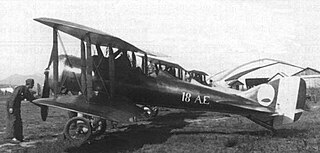 W
WThe Nieuport-Delage NiD 32 was a French single-seater fighter produced by Nieuport during the period between the two World Wars. The aircraft was designed in response to a request from the French Navy for an aircraft capable of launching from a platform: the NiD 32 competed with other planes, such as the Hanriot HD.12 and the SPAD S.XV. In addition to the NiD 32, Nieuport also submitted the NiD 29. The Navy selected the Nieuport NiD 32, and set about to test it in March 1920 on a platform. The results were disappointing, as the platform could barely support the aircraft, even when it was unarmed.
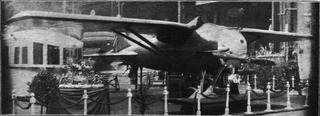 W
WThe Nieuport-Delage NiD 37 was a single-engine, single-seat monoplane fighter aircraft and racer designed and built in France in the early 1920s. It had a small foreplane to bring the centre of pressure forward. Heavy, slower than expected and with turbo-supercharger problems, development ended without any entering service.
 W
WThe Nieuport-Delage NiD 42 was a fighter aircraft built in France in the early 1920s, the first in a family of designs that would form the backbone of the French fighter force over the next decade.
 W
WThe Nieuport-Delage NiD 43 was a single engine, two seat biplane fighter aircraft designed and built for shipboard use in France in 1924.
 W
WThe Nieuport-Delage NiD 48 was a French single-engine parasol wing light fighter aircraft, designed and built in the 1920s. Its performance was not markedly better than that of the much heavier Nieuport-Delage NiD 62 then going into production, so only two were flown.
 W
WThe Nieuport-Delage NiD 52 was a French fighter aircraft of the 1920s. A single-engined sesquiplane, it served with the Spanish Air Force, being operated by both sides of the Spanish Civil War.
 W
WThe Potez 31 was a prototype French two-seat night fighter, flown in about 1928, intended to fill the Cn.2 specification for the Armee de l'Air. Only one was built.
 W
WThe Potez XI was the first fighter aircraft designed by the French company Potez. Designed in 1922, the only aircraft first flew on December 11 of that year, after which further development work stopped. It was built to meet CAP 2 requirements created in 1919 by the new director of Aeronautics, General Duval. It was to perform bomber, intercept and tactical reconnaissance for the military, as well as escort fighters. The aircraft was to be powered by a turbo-supercharged engine.
 W
WThe Salmson-Béchereau SB-5 was a two-seat fighter aircraft built for a French government programme in 1925. Despite a powerful engine it did not perform well and only one was built.
 W
WThe Villiers II was a French two-seat fighter aircraft of the 1920s intended for operation from the Aircraft carrier Béarn of the French Navy. It was a single-engined tractor biplane with a waterproof hull in the form of a flying boat to allow the aircraft to be safely landed on water in an emergency. Two prototypes and 30 production aircraft were built, the type serving briefly with the French Navy, although never operated from an aircraft carrier.
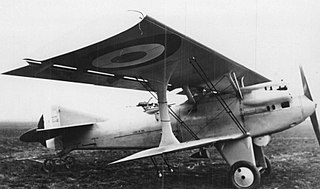 W
WThe Villiers XXIV or Villiers 24 CAN2 was a French army night fighter most notable as the first French military aircraft to be fitted with leading edge slats.
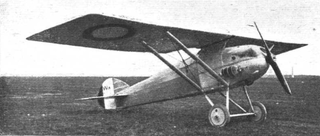 W
WThe Wibault 3 or Wibault Wib 3 C.1 was a French parasol wing prototype fighter aircraft from the 1920s, designed for high altitude operations. Its development was abandoned after repeated materials failure in its supercharger.
 W
WThe Wibault 7 was a 1920s French monoplane fighter designed and built by Société des Avions Michel Wibault. Variants were operated by the French and Polish military and built under licence for Chile as the Vickers Wibault.
 W
WThe Wibault 8 or Wib 8 Simoun (Simoon) was a tandem seat, parasol wing fighter aircraft designed and built in France to a 1925 specification which was later withdrawn; only one Wib 8 was completed.
 W
WThe Wibault 12 Sirocco or Wib 12 Sirocco was a two-seat, parasol wing fighter aircraft designed and built in France in the 1920s. Three fighter prototypes were completed, one for the RAF and two Army co-operation variants. There was no series production.
 W
WThe Wibault 13C.1 Trombe (Whirlwind), later known as the Wib 130C.1 Trombe was a single seat, parasol wing lightweight fighter aircraft designed and built in France in the 1920s. It was developed into the more powerful Wib 170C.1 Tornade (Tornado) but government interest in lightweight fighters soon waned.
 W
WThe Wibault Wib 210 C.1 was a single engine, single seat low wing monoplane fighter aircraft, designed and built in France in the late 1920s. Flight tests revealed vibration problems and development was quickly abandoned.